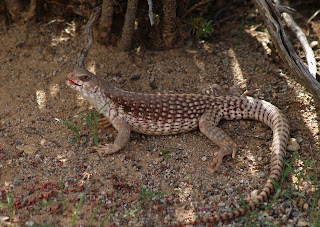
Since their introduction to the US from the Mediterranean and Asia several Saltcedar or tamarisk species, especially Tamarix ramosissima, developed into noxious weeds of riparian areas. In these valuable, but often fragile biotopes, tamarisks are replacing native willows, poplars and alders at an alarming rate with fast growing monocultures. So far there are no controlling natural enemies. In Arizona, solid stands of tamarisk can be seen for example at the Colorado River at Yuma and the San Pedro River at Benson.
Research and politics:
Researchers have studied tamarisks in Asia and Europe to find organisms usable as biological control of the spreading weed. Among the 'pests' that are tied to the tamarisk by close co-evolution in Asia and Europe (and thus would hopefully not attack any hosts other than tamarisk if introduced to the US), is the weevil Coniatus tamarisci. Efforts to get approval for its release here were underway for years, but were counteracted by naturalist groups mainly focused on birds because rare Willow Flycatchers are nesting in the tamarisk thickets. The United States Department of Agriculture claims not to have released the weevils from strict quarantine.
Field observations:

Last fall fellow arthropod researcher Jillian Cowles showed Charles O'Brien, our world expert on weevils, photos of a pretty little bug that she'd found on tamarisk bushes in Vail, Arizona. Charlie and Jens Prena recognized it as Coniatus splendidulus. This was the second time this species was found in the US, Charlie had received specimens from Phoenix, AZ in 2006.
So far we don't know how it got to the US. Could it have hitchhiked on a transport coming back from the war in Irak? This spring, it was found in Gilbert (Maricopa County), as well as along the Santa Cruz River from Marana (NW Pima County) to Amado (Santa Cruz County). The beetles fly well and will spread quickly, it seems.
Live Cycle: here's a video of a mating attempt
 |
| Mating pair in early May 2011 |
Adult beetles hibernate in soil and litter close to the trees. In Arizona, they climb the trees by the end of March, feed on fresh shoots, mate, and begin laying their eggs in early April. The image shows an unusually dark male competing for access to the female, and an egg in the lower right corner. Eggs are usually placed in a cavity that the female chews and then covered with the chewed material. Oviposition as shown here sometimes occurs in captivity or under stress.


From mid April to early May larvae were feeding on leaves and flowers together with the adults. They live free and unprotected on the surface of the plant, an unusual strategy in weevils.

When they are ready to pupate the larvae spin retinous web cocoons that
 serve as protective cages. They place them in the open at the tips of twigs, sometimes in clusters. Larvae, and then later pupae, can be seen wiggling inside through the loose mesh.
serve as protective cages. They place them in the open at the tips of twigs, sometimes in clusters. Larvae, and then later pupae, can be seen wiggling inside through the loose mesh.

By mid May most have emerged as beetles. From Asia, Kovalev describes two generations per year. Here in Arizona there may be time for one more, or the beetles may take an aestivation pause during the dry hot season that's approaching.

At the Santa Cruz River the beetles seemed to prefer immature young trees. These hosts appeared clearly set back in their development compared to beetle free trees.
P.s.: Another tamarisk 'pest' the leaf beetle Diorhabda elongata is being released since 2004 in Utah and Colorado. Check this site for more info
P.p.s.: Diorhabda elongata, Trabutina mannipara (Mealybug) and Coniatus tamarisci were approved for release in 1996 Check here for more info. Only the leaf beetle was eventually released, but not in Arizona and New Mexico, where the Willow Flycatcher was found breeding in tamarisk.
April 2021: Coniatus splendidulus on a window screen in Oro Valley, Pima Co., AZ. Certainly no single occurrences anymore.
Literature:
Kovalev, 1995, Co-evolution of the tamarisks (Tamariceae) and pest arthropods () with special reference to biological control prospects. Proceedings of the Zoological Institute of the Russian Academy of Sciences. St. Peterburg, vol. 259
Dudley, T.L. 2005, Progress and pitfalls in the biological control ofSaltcedar (Tamarix spp.) in North America. Proceedings 16th USDA interagency forum on Gypsy Moth and other invasive species
Literature:
Kovalev, 1995, Co-evolution of the tamarisks (Tamariceae) and pest arthropods () with special reference to biological control prospects. Proceedings of the Zoological Institute of the Russian Academy of Sciences. St. Peterburg, vol. 259
Dudley, T.L. 2005, Progress and pitfalls in the biological control ofSaltcedar (Tamarix spp.) in North America. Proceedings 16th USDA interagency forum on Gypsy Moth and other invasive species





































